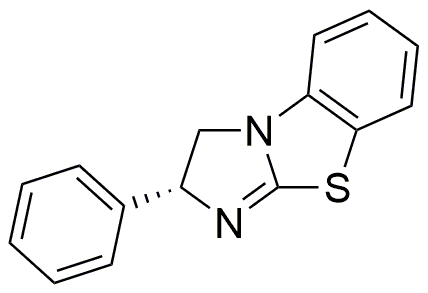(+)-Benzotetramisole is widely utilized in research focused on
- Agriculture: This compound serves as an effective anthelmintic agent in veterinary medicine, helping to control parasitic infections in livestock, which can improve animal health and productivity.
- Pharmaceuticals: It is explored for its potential in drug formulations aimed at enhancing immune responses, particularly in immunocompromised patients, thereby offering a novel approach to treatment.
- Biochemistry: Researchers use it as a tool to study enzyme inhibition, particularly in the context of drug metabolism, providing insights into how drugs are processed in the body.
- Environmental Science: The compound is investigated for its role in soil health, as it can influence microbial activity, which is crucial for nutrient cycling and plant growth.
- Food Safety: Its applications extend to detecting and controlling parasitic contaminants in food products, ensuring safer consumption and compliance with health regulations.
General Information
Properties
Safety and Regulations
Applications
(+)-Benzotetramisole is widely utilized in research focused on
- Agriculture: This compound serves as an effective anthelmintic agent in veterinary medicine, helping to control parasitic infections in livestock, which can improve animal health and productivity.
- Pharmaceuticals: It is explored for its potential in drug formulations aimed at enhancing immune responses, particularly in immunocompromised patients, thereby offering a novel approach to treatment.
- Biochemistry: Researchers use it as a tool to study enzyme inhibition, particularly in the context of drug metabolism, providing insights into how drugs are processed in the body.
- Environmental Science: The compound is investigated for its role in soil health, as it can influence microbial activity, which is crucial for nutrient cycling and plant growth.
- Food Safety: Its applications extend to detecting and controlling parasitic contaminants in food products, ensuring safer consumption and compliance with health regulations.
Documents
Safety Data Sheets (SDS)
The SDS provides comprehensive safety information on handling, storage, and disposal of the product.
Product Specification (PS)
The PS provides a comprehensive breakdown of the product’s properties, including chemical composition, physical state, purity, and storage requirements. It also details acceptable quality ranges and the product's intended applications.
Certificates of Analysis (COA)
Search for Certificates of Analysis (COA) by entering the products Lot Number. Lot and Batch Numbers can be found on a product’s label following the words ‘Lot’ or ‘Batch’.
Numéro de catalogue
Numéro de lot/série
Certificates Of Origin (COO)
This COO confirms the country where the product was manufactured, and also details the materials and components used in it and whether it is derived from natural, synthetic, or other specific sources. This certificate may be required for customs, trade, and regulatory compliance.
Numéro de catalogue
Numéro de lot/série
Safety Data Sheets (SDS)
The SDS provides comprehensive safety information on handling, storage, and disposal of the product.
DownloadProduct Specification (PS)
The PS provides a comprehensive breakdown of the product’s properties, including chemical composition, physical state, purity, and storage requirements. It also details acceptable quality ranges and the product's intended applications.
DownloadCertificates of Analysis (COA)
Search for Certificates of Analysis (COA) by entering the products Lot Number. Lot and Batch Numbers can be found on a product’s label following the words ‘Lot’ or ‘Batch’.
Numéro de catalogue
Numéro de lot/série
Certificates Of Origin (COO)
This COO confirms the country where the product was manufactured, and also details the materials and components used in it and whether it is derived from natural, synthetic, or other specific sources. This certificate may be required for customs, trade, and regulatory compliance.


